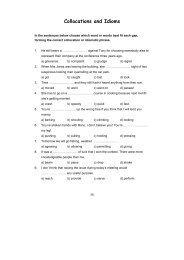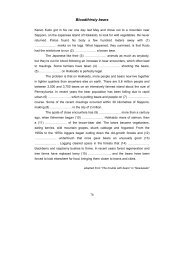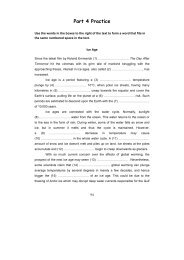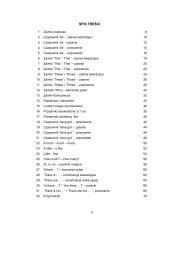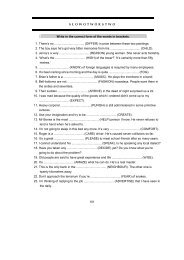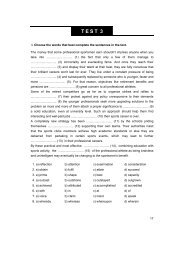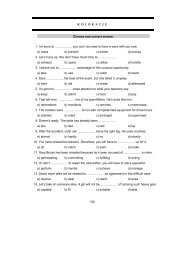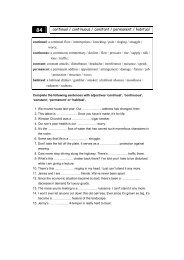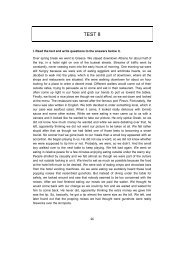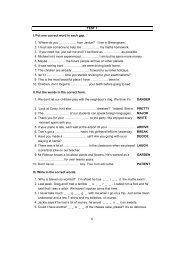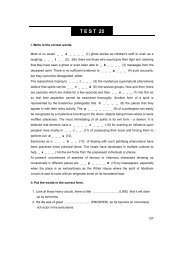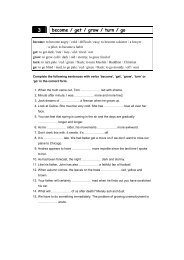1. PRESENT SIMPLE - HandyBooks
1. PRESENT SIMPLE - HandyBooks
1. PRESENT SIMPLE - HandyBooks
You also want an ePaper? Increase the reach of your titles
YUMPU automatically turns print PDFs into web optimized ePapers that Google loves.
<strong>1.</strong> <strong>PRESENT</strong> <strong>SIMPLE</strong><br />
twierdzenie pytanie przeczenie<br />
I work do I work I do not work<br />
you work do you work you do not work<br />
he works does he work he does not work<br />
she works does she work she does not work<br />
it works does it work it does not work<br />
we work do we work we do not work<br />
you work do you work you do not work<br />
they work do they work they do not work<br />
skrócone formy przeczące: do not = don’t does not = doesn’t<br />
Cechą charakterystyczną czasu Present Simple jest końcówka ‘-s’ przy trzeciej<br />
osobie liczby pojedynczej oraz operator ‘do / does’ tworzący pytania i zaprzeczenia.<br />
Do czasowników zakończonych spółgłoską ‘syczącą’ tj. ‘ss, sh, x, ch’ w trzeciej<br />
osobie liczby pojedynczej dodaje się końcówkę ‘-es’ np.<br />
Mike watches television every evening.<br />
Susan brushes her teeth three times a day.<br />
Czas Present Simple stosowany jest w celu wyraŜenia:<br />
a) czynności wykonywanej regularnie z określoną częstotliwością w ogólnie pojętej<br />
teraźniejszości. Czynność w Present Simple moŜe zostać opisana jednym z<br />
przysłówków częstotliwości:<br />
always, often, seldom, sometimes, usually, never<br />
lub przy pomocy określenia z ‘every’ np.<br />
every day, every week, every month itp.<br />
I always ask my older brother for help.<br />
We never sit together in the classroom.<br />
The Greens work in their garden every afternoon.<br />
119
) czynności będącej formą nawyku, przyzwyczajenia lub zwyczaju np.<br />
Mary always forgets to lock the front door.<br />
John gets up at dawn and practices yoga every morning.<br />
c) czynności będącymi ogólnie obowiązującymi prawidłami natury, fizyki itp. np.<br />
d) stanu, opinii lub wraŜenia np.<br />
I don’t agree with you.<br />
I regret calling him names.<br />
Water boils at 100 degrees.<br />
It snows in winter.<br />
Sam does not believe in ghosts.<br />
Inne czasowniki wyraŜające podobne znaczenia to m.in.:<br />
How much do you weigh<br />
believe, belong to, cost, depend, disagree, doubt, feel, guess, hate, have,<br />
have to, hope, know, like, look, love, matter, mean, possess, prefer, realise,<br />
understand, see, seem, smell, suppose, taste, think, want, weigh, wish<br />
Czas Present Simple stosowany jest takŜe w celu przytoczenia czyjejś wypowiedzi,<br />
lub myśli np.<br />
Alan says that he is the best student.<br />
Tommy thinks that you are Sam’s brother.<br />
Patricia believes that she can become famous.<br />
Present Simple uŜywany jest zamiast czasu Present Continuous z czasownikami<br />
opisującymi czynności umysłowe oraz czynności narządów zmysłów:<br />
hear, like, look, love, mind, smell, taste, think, want, wish<br />
np.<br />
I want to leave earlier today.<br />
Monica looks beautiful, doesn’t she<br />
Is the meat good How does it taste<br />
e) instrukcji, oficjalnego planu podróŜy lub wizyty np.<br />
First, you pour hot water in a jug. Then, you put a tea bag in it.<br />
On Monday, we go to Paris and stay there for three days.<br />
At six, the minister gives a speech in the Parliament.<br />
120
f) opisu wydarzeń historycznych, treści filmu, sztuki lub ksiąŜki np.<br />
In the first scene of the film, the old king dies in a battle.<br />
In the last chapter, the two friends return home safely.<br />
g) Czas Present Simple stosowany jest takŜe w nagłówkach gazet np.<br />
Peace talks begin in the Middle East.<br />
All passengers survive a plane crash.<br />
A boy of twelve rescues a drowning girl.<br />
oraz do interpretacji, relacji lub objaśnienia znaczenia tego, co zostało przeczytane,<br />
napisane, zaobserwowane lub zasłyszane np.<br />
That explains his disappointment.<br />
The book describes the true life of the painter.<br />
2. <strong>PRESENT</strong> CONTINUOUS<br />
twierdzenie pytanie przeczenie<br />
I am travelling am I travelling I am not travelling<br />
you are travelling are you travelling you are not travelling<br />
he is travelling is he travelling he is not travelling<br />
she is travelling is she travelling she is not travelling<br />
it is travelling is it travelling it is not travelling<br />
we are travelling are we travelling we are not travelling<br />
you are travelling are you travelling you are not travelling<br />
they are travelling are they travelling they are not travelling<br />
skrócone formy przeczące: are not = aren’t is not = isn’t<br />
Cechą szczególną czasu Present Continuous jest końcówka ‘-ing’ dodawana do<br />
głównego czasownika. Czasownikiem posiłkowym jest teraźniejsza odmiana ‘be’.<br />
W większości przypadków jeŜeli czasownik zakończony jest samogłoską ‘e’ po<br />
dodaniu końcówki ‘-ing’ samogłoska ta jest opuszczana np.<br />
compare - comparing glare - glaring stare – staring<br />
121
W przypadku czasowników jednosylabowych oraz niektórych dwusylabowych<br />
zakończonych spółgłoską przed którą znajduje się samogłoska, po dodaniu<br />
końcówki ‘-ing’ spółgłoska ta ulega podwojeniu np.<br />
set - setting nod - nodding control - controlling<br />
Czas Present Continuous stosowany jest w celu wyraŜenia:<br />
a) czynności trwającej obecnie. Czynność taka moŜe dodatkowo być określona<br />
wyraŜeniem czasowym ‘now’, ‘at the moment’, ‘at the present moment’ np.<br />
I am listening to classical music at the moment.<br />
Are the children playing in the park now<br />
Where is he going right now<br />
b) czynności wykonywanej obecnie, choć niekoniecznie w momencie, gdy o niej<br />
mówimy np.<br />
We are driving to the seaside, but we have stopped for lunch.<br />
Michael is cutting the grass in the garden this morning.<br />
Many species of animals are dying out.<br />
c) czynności wykonywanej w określony sposób tymczasowo lub w drodze wyjątku<br />
np.<br />
Only this month, we are working till six.<br />
We’re cutting the prices this week.<br />
Czas Present Continuous moŜe być stosowany z czasownikami opisującymi<br />
zachodzące zmiany lub trwające procesy dla podkreślenia ich ciągłości np.<br />
Times are changing and so are people.<br />
The water in the river is getting dirtier and dirtier.<br />
Present Continuous jest często stosowany z przysłówkami:<br />
always, constantly, continually lub forever<br />
dla podkreślenia czynności powtarzającej się. Zastosowanie to często dotyczy<br />
czynności, która moŜe być irytująca dla osoby opisującej ją i dlatego tak wyraŜone<br />
znaczenie moŜe mieć zabarwienie niezadowolenia lub krytyki np.<br />
122
You are always forgetting to lock the door.<br />
My old car is continually giving me trouble.<br />
Why are the neighbours’ children always screaming<br />
d) czynności zaplanowanej w nieodległej przyszłości. UŜywając czas Present<br />
Continuous w tym znaczeniu naleŜy pamiętać o konieczności zastosowania<br />
wyraŜenia czasowego określającego czas wykonania danej czynności. W<br />
przeciwnym razie moŜe ona zostać zinterpretowana jako czynność trwająca w<br />
chwili obecnej np.<br />
‘What are you doing this evening’ ‘I am going to the cinema.’<br />
The Parkers are visiting us tomorrow.<br />
We are leaving soon.<br />
123



